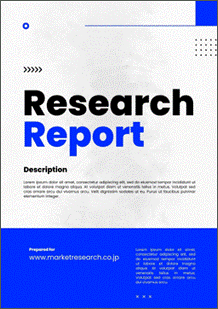 | • レポートコード:MRC2203A259 • 出版社/出版日:Mordor Intelligence / 2022年1月 • レポート形態:英文、PDF、100ページ • 納品方法:Eメール(受注後2-3営業日) • 産業分類:食品 |
| Single User | ¥703,000 (USD4,750) | ▷ お問い合わせ |
| Site Licence | ¥962,000 (USD6,500) | ▷ お問い合わせ |
| Corporate License | ¥1,295,000 (USD8,750) | ▷ お問い合わせ |
• お支払方法:銀行振込(納品後、ご請求書送付)
レポート概要
| Mordor Intelligence社の本市場調査レポートでは、世界の商業用海藻市場について調査・分析し、イントロダクション、調査手法、エグゼクティブサマリー、市場動向、製品種類別(褐海藻、緑藻類、紅海藻)分析、用途別(食品・飲料、栄養補助食品、医薬品、その他)分析、地域別(北米、ヨーロッパ、アジア太平洋、南米、中東・アフリカ)分析、競争状況、市場機会・将来傾向、新型コロナウイルス感染症による市場への影響など、以下の構成でまとめました。 ・イントロダクション ・調査手法 ・エグゼクティブサマリー ・市場動向 ・世界の商業用海藻市場規模:製品種類別(褐海藻、緑藻類、紅海藻) ・世界の商業用海藻市場規模:用途別(食品・飲料、栄養補助食品、医薬品、その他) ・世界の商業用海藻市場規模:地域別(北米、ヨーロッパ、アジア太平洋、南米、中東・アフリカ) ・競争状況(Cargill Incorporated、DuPont de Nemours, Inc、Acadian Seaplants、…) ・市場機会・将来傾向 ・新型コロナウイルス感染症による市場への影響 |
The global commercial seaweed market is projected to grow with CAGR of 9.7% during the forecast period, 2020 – 2025.
Key Highlights
- The commercial seaweed market is predominantly driven by the functional and healthy properties of edible seaweed. Most of the commercially produced seaweed is used in the food industry, which accounts for more than half of the total market share compare to other categories which include hydrocolloids, feed, and fertilizers.
- Sales of seaweed soared, owing to weight-loss claims. Seaweed can rehydrate and swell up in the stomach. Globally, seaweeds are gaining popularity at present not only as part of the staple diet, food flavor enhancers, and nutritive food items but also for their weight loss property. For this very reason, the consumption of seaweed has increased by 125% in the United Kingdom alone.
Impact of COVID-19 on the Market:
Key Highlights
- The COVID-19 epidemic has directly affected seaweed farmers as demand for raw materials has decreased and prices have fallen. For instance, in Indonesia, the price of mainly exported Cottonii seaweed, used for producing carrageenan (an additive used to thicken, emulsify, and preserve foods and drinks), has declined by almost 50% since trade with China, the biggest export market, has been disrupted since February.
- However, seaweed’s potential to fight Covid-19 is being recognised in many research studies carried out by the organizations such as World Health Organisation (WHO), which is thereby creating ample room to rebalance the seaweeds industry even in the face of persistent COVID-19 restrictions. Also, in regions like Bali, which was earlier known for seaweed farming, but the seaweed industry were paralysed by the tourism sector, now have reverted immediately back to their seaweed farms as a result of tourism skrinkage due to COVID within the country.
Key Market Trends
Higher Benefits with Enhanced Yield and Productivity
Agriculture is a critical sector for the livelihood of individuals and the stability of the overall global economy. Meeting the food needs and its productivity requirements in the future are of tremendous importance owing to the increasing global population. These requirements can be achieved through a set of innovations and technologies that have recently come up in support of the agriculture sector; one among them is using seaweed extract to boost agricultural production. Liquid seaweed extracts are complex and have demonstrated to possess novel mechanisms for increasing crop productivity.
Moreover, the other benefits include improved root structures, improved plant development like flowering and leaf development and fruit set, and enhanced ability to tolerate plant disease and climatic stresses, such as cold or drought. They also help in improving soil structure, soil water holding capacity, and improved soil microbiology. The graph provided shows the market of seaweeds taken by the source World Bank Group.
Asia-pacific Held the Largest Share of the Commercial Seaweed Market
The use of seaweed as food has strong roots in Asian countries, such as China, Japan, and the Republic of Korea, the demand for seaweed as food has spread to North America, South America, and Europe. China is by far the largest seaweed producer, followed by the Republic of Korea and Japan. However, seaweeds are now being produced on all continents.
The United States, Mexico, and Canada are poised to witness a high growth rate in the seaweed market. Rapid industrialization, coupled with environment-friendly regulations, is anticipated to benefit the growth of the market for commercial seaweed in these regions.
Competitive Landscape
The global commercial seaweed market is highly fragmented and competitive in nature. Cargill Inc., DuPont, Acadian Seaplants Limited, CP Kelco, Algae, the arctic company, Fruit Hill Farm, and Kelpak are the most active companies among all major players in this market. The companies that have taken the lead in strategic movements are Cargill Inc. and CP Kelco. Most of the key players are based in developed countries of Asia- Pacific, European region, and North America. At the same time, their subsidiaries and branches are established in many countries of South America and Eastern European countries, the Middle East, and the Oceana region.
Additional Benefits:
- The market estimate (ME) sheet in Excel format
- 3 months of analyst support
1 INTRODUCTION
1.1 Study Assumptions and Market Definition
1.2 Scope of the Study
2 RESEARCH METHODOLOGY
3 EXECUTIVE SUMMARY
4 MARKET DYNAMICS
4.1 Market Drivers
4.2 Market Restraints
4.3 Porter’s Five Forces Analysis
4.3.1 Threat of New Entrants
4.3.2 Bargaining Power of Buyers/Consumers
4.3.3 Bargaining Power of Suppliers
4.3.4 Threat of Substitute Products
4.3.5 Intensity of Competitive Rivalry
5 MARKET SEGMENTATION
5.1 By Product Type
5.1.1 Brown Seaweed
5.1.2 Green Seaweed
5.1.3 Red Seaweed
5.2 By Application
5.2.1 Food and Beverage
5.2.2 Dietary Supplements
5.2.3 Pharmaceuticals
5.2.4 Other Applications
5.3 By Geography
5.3.1 North America
5.3.1.1 United States
5.3.1.2 Canada
5.3.1.3 Mexico
5.3.1.4 Rest of North America
5.3.2 Europe
5.3.2.1 Germany
5.3.2.2 United Kingdom
5.3.2.3 France
5.3.2.4 Spain
5.3.2.5 Russia
5.3.2.6 Italy
5.3.2.7 Rest of Europe
5.3.3 Asia-Pacific
5.3.3.1 China
5.3.3.2 India
5.3.3.3 Japan
5.3.3.4 Australia
5.3.3.5 Rest of Asia-Pacific
5.3.4 South America
5.3.4.1 Brazil
5.3.4.2 Colombia
5.3.4.3 Rest of South America
5.3.5 Middle East & Africa
5.3.5.1 United Arab Emirates
5.3.5.2 South Africa
5.3.5.3 Rest Middle East & Africa
6 COMPETITIVE LANDSCAPE
6.1 Most Adopted Strategies
6.2 Most Active Companies
6.3 Market Position Analysis
6.4 Company Profiles
6.4.1 Cargill Incorporated
6.4.2 DuPont de Nemours, Inc
6.4.3 Acadian Seaplants
6.4.4 CP Kelco US Inc.
6.4.5 Brandt Consolidated Inc.
6.4.6 Seasol International
6.4.7 Gelymar
6.4.8 Algaia SA
7 MARKET OPPORTUNITIES AND FUTURE TRENDS
8 IMPACT OF COVID-19 ON THE MARKET